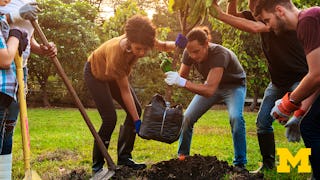Welcome to the American Museum of Natural History's (AMNH) primer called Climate and Climate Change in New Jersey! This primer includes numerous elements that will provide you with an understanding of our climate system and climate change in New Jersey, and encourage you to think about viable solutions for climate change impacts. It is divided into four parts, which may be completed sequentially as it was designed or in your sequence. We estimate that it will take approximately 2.5 hours to complete. We are also happy to inform you that you can receive 2.5 professional development hours and a Certificate of Attendance upon successful completion of this course.



(15 Bewertungen)
Wichtige Details

Zu Ihrem LinkedIn-Profil hinzufügen
4 Aufgaben
Erfahren Sie, wie Mitarbeiter führender Unternehmen gefragte Kompetenzen erwerben.


Erwerben Sie ein Karrierezertifikat.
Fügen Sie diese Qualifikation zur Ihrem LinkedIn-Profil oder Ihrem Lebenslauf hinzu.
Teilen Sie es in den sozialen Medien und in Ihrer Leistungsbeurteilung.

In diesem Kurs gibt es 4 Module
Welcome to the American Museum of Natural History's (AMNH) primer called Climate and Climate Change in New Jersey! This primer includes numerous elements that will provide you with an understanding of our climate system and climate change in New Jersey, and encourage you to think about viable solutions for climate change impacts. It is divided into four parts, which may be completed sequentially as it was designed or in your own sequence. We estimate that it will take approximately 2.5 hours to complete. We are also happy to inform you that you can receive 2.5 professional development hours and a Certificate of Attendance upon successful completion of this course. Below is Part One of our primer (labeled as Week One in the navigation bar). The resources in this part introduce you to the layout of the primer and the basics of our global climate system and New Jersey’s climate system. To guide your learning, we selected “sunny-day flooding” (also called tidal or nuisance flooding) as an anchoring phenomenon. The learning in each part of the primer will reveal another piece of this issue, which is becoming more and more prevalent in our coastal communities here in New Jersey. To begin, Dr. David Robinson, a Professor of Geography at Rutgers University, and the New Jersey State Climatologist, will introduce you to what is in store in a short video.
Das ist alles enthalten
2 Videos5 Lektüren1 Aufgabe
Before we look into the evidence of climate change, it is important to understand why our climate is changing. In the first video, Dr. Debra Tillinger, an oceanographer, describes the mechanisms causing our atmosphere to warm, and explains why the warming varies around the globe. In the final video of this section, Dr. Robinson provides more information about the evidence for climate change in New Jersey, and helps make the connection between sunny-day flooding and climate change in New Jersey.
Das ist alles enthalten
2 Videos5 Lektüren1 Aufgabe
Now that we have an understanding of the basics of our climate system and we have explored evidence of global and local climate change, we want to understand what to expect in the future. To do this, we need to explore feedbacks and forcings that move our climate system away from stability. Watch the video “What are Feedbacks and Forcings?”, in which Dr. Tillinger explains how feedbacks and forcings affect the climate system. Understanding these interactions will help us understand the challenges of creating models to predict the future of our climate system. In his third video, Dr. Robinson explains how we monitor the climate system, including sea level rise, in New Jersey. What can we expect to happen to sea levels in New Jersey in the future? Can we expect more sunny-day flooding?
Das ist alles enthalten
2 Videos2 Lektüren1 Aufgabe
In this final part of the course, we will explore the impacts of climate change in New Jersey, and what can be done about it. In his final remarks, Dr. Robinson wraps up what we know about sunny-day flooding now and in the future, and provides his thoughts about solutions for the climate change impacts in New Jersey.
Das ist alles enthalten
1 Video3 Lektüren1 Aufgabe
Dozent

Empfohlen, wenn Sie sich für Basic Science interessieren


Council on Foreign Relations


University of Colorado Boulder


Duke University


University of Michigan
Warum entscheiden sich Menschen für Coursera für ihre Karriere?




Bewertungen von Lernenden
15 Bewertungen
- 5 stars
66,66 %
- 4 stars
26,66 %
- 3 stars
6,66 %
- 2 stars
0 %
- 1 star
0 %
Zeigt 3 von 15 an
Geprüft am 30. Juli 2022
Informational and easy to see relevance to my current teaching situation. Eye opening to the necessity of not only mitigating but adapting to avoid dire consequeneces of climate change.
Geprüft am 11. Feb. 2023
The course is well-taught. We learned about atmospheric warming ,sea level rise, feedback, forcings, climate models, climate prediction, and climate impacts and solutions in New Jersey.

Neue Karrieremöglichkeiten mit Coursera Plus
Unbegrenzter Zugang zu 10,000+ Weltklasse-Kursen, praktischen Projekten und berufsqualifizierenden Zertifikatsprogrammen - alles in Ihrem Abonnement enthalten
Bringen Sie Ihre Karriere mit einem Online-Abschluss voran.
Erwerben Sie einen Abschluss von erstklassigen Universitäten – 100 % online
Schließen Sie sich mehr als 3.400 Unternehmen in aller Welt an, die sich für Coursera for Business entschieden haben.
Schulen Sie Ihre Mitarbeiter*innen, um sich in der digitalen Wirtschaft zu behaupten.
Häufig gestellte Fragen
Access to lectures and assignments depends on your type of enrollment. If you take a course in audit mode, you will be able to see most course materials for free. To access graded assignments and to earn a Certificate, you will need to purchase the Certificate experience, during or after your audit. If you don't see the audit option:
The course may not offer an audit option. You can try a Free Trial instead, or apply for Financial Aid.
The course may offer 'Full Course, No Certificate' instead. This option lets you see all course materials, submit required assessments, and get a final grade. This also means that you will not be able to purchase a Certificate experience.
When you purchase a Certificate you get access to all course materials, including graded assignments. Upon completing the course, your electronic Certificate will be added to your Accomplishments page - from there, you can print your Certificate or add it to your LinkedIn profile. If you only want to read and view the course content, you can audit the course for free.
You will be eligible for a full refund until two weeks after your payment date, or (for courses that have just launched) until two weeks after the first session of the course begins, whichever is later. You cannot receive a refund once you’ve earned a Course Certificate, even if you complete the course within the two-week refund period. See our full refund policy.
Weitere Fragen
Finanzielle Unterstützung verfügbar,
 enthalten
enthalten
